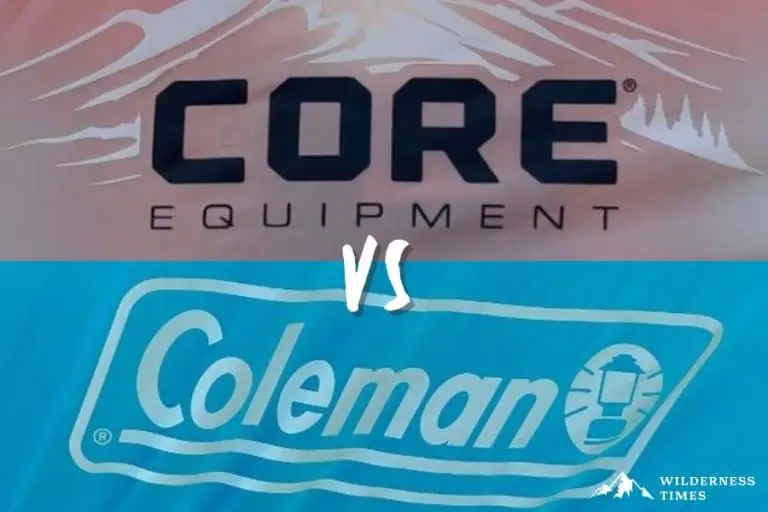Both brands are known for affordable prices and decent quality, but which is better?
That’s not an easy question to answer…at all – depending on what type of tent you are looking for, one may be better than the other.
In our opinion, on average CORE tents are superior to Coleman tents.
With higher average scores on several key metrics from quality & durability to value to what tent owners say in their reviews, CORE is the clear winner of this battle:
CORE | Coleman | |
Best For | Value Brand | Budget Brand |
Price | $ | $ |
Sizes | 4 to 12 | 2 to 12 |
Warranty | 1 Year (Limited) | 1 Year (Limited) |
Average Tent Score | 8.0 | 7.4 |
Space & Comfort | ||
Quality & Durability | ||
Weather Resistance | ||
Tent Variety | ||
Value | ||
Ease of Use | ||
User Reviews |
Coleman Vs. CORE Tents
Nowadays, both CORE Equipment and Coleman enjoy their popularity as reliable brands in the camping industry.
But how do they compare to one another? Head-to-head CORE certainly comes out on top, and we’ll explain why below:
Design Innovations & Unique Features
One thing that’s true for both brands is that their budget tents are designed with ease of use in mind.
In other words, you don’t need to spend time deciphering a manual and some more just figuring out which part goes where.
In a way, we can say that both tent brands have mostly simple and easy-to-use designs.
Then on top of that, each company tends to favor specific features over others.
CORE has some features that Coleman doesn’t and vice versa…so here we go:
CORE Features
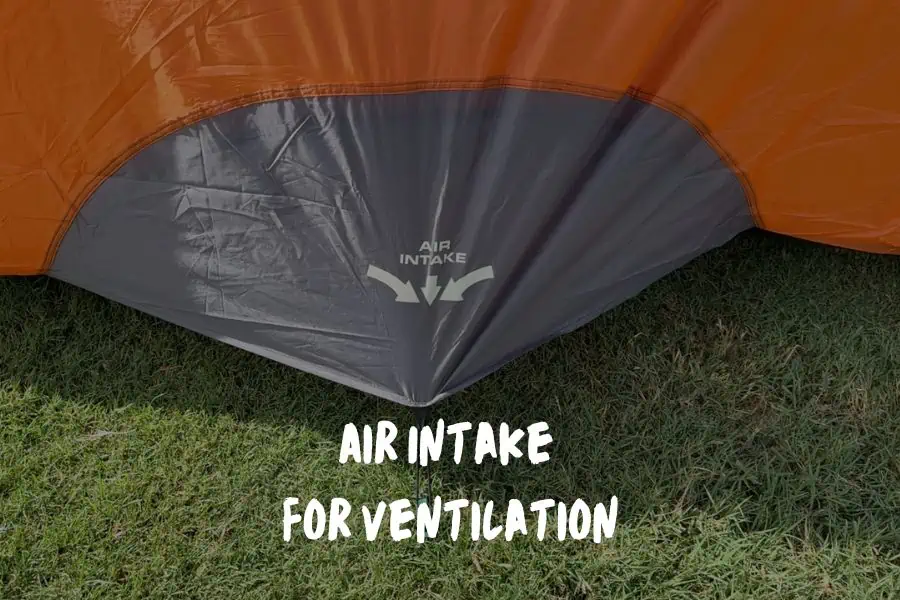
When it comes to CORE tents, the first feature to mention is rain fly buckles.
While a good portion of tents on the market feature elastic strainers on each end of the rain fly, CORE has replaced many models with buckles.
What makes buckles superior is you can easily adjust the tautness of the rain fly, without having to stake it further away from the tent.
Another feature you can find on every CORE tent is an electrical port. What it does is it allows you to extend the electric cord into the tent, without having to keep the door or window unzipped.
The E-port is designed in such a way as to fit the cord while leaving no room for water to find its way into the tent.
Coleman tents may also come with an electrical port, but that’s usually the case only with larger, family tents.
Finally, ventilation is a priority on CORE tents, and every model will most certainly have an air intake vent or two on either side of the tent to help improve cross-circulation.
Coleman Features
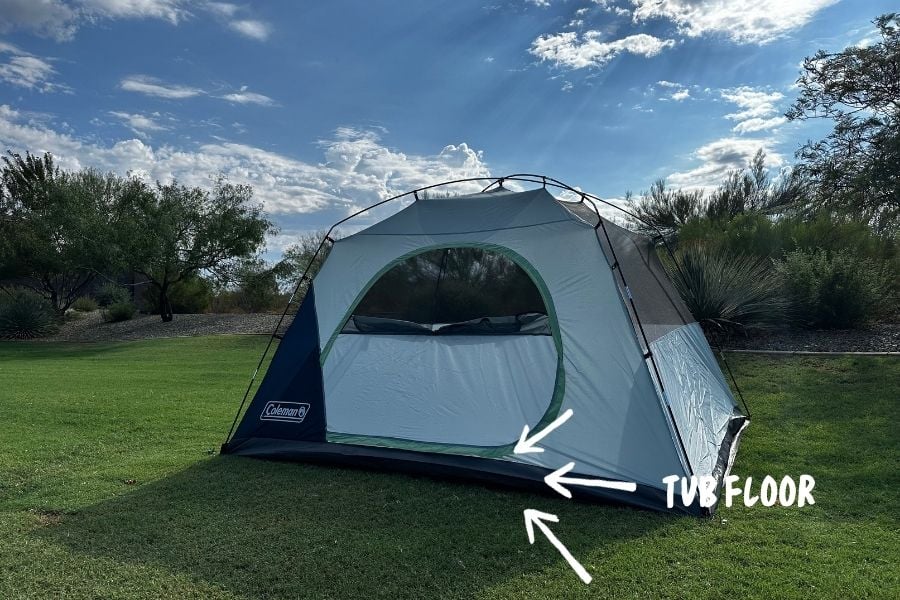
Of course, Coleman also offers some unique features, one being the hinged door.
Mostly found on larger models, the hinged door makes getting in and out of the tent a breeze.
Basically, the tent door opens up like the real door you have at home! You don’t have to deal with flaps or constant zipping and unzipping. Especially when you’re constantly getting in and out, like when you’re just setting up your campsite.
It’s also worth mentioning that Coleman has several tent series that feature inflatable poles. These tents are pretty quick and easy to install, even for a solo camper.
You need to push out the nozzle of the high-pressure valve, screw on the pump’s hose and inflate the pole to the recommended pressure.
But the hallmark feature of Coleman tents is their bathtub floor. Found on every tent, the tub floor helps to keep water out of the tent by extending the flooring material up the walls of the tent by about 6 inches.
Verdict: Both brands have unique selling points. Tie!
Tent Materials & Durability
A tent is not intended to be replaced every few years. In fact, a good tent should last you over a decade.
So, how durable are CORE and Coleman tents?
When it comes to durability, material plays a huge role, and those really come down to two elements:
- Fabric material
- Pole material
Material Types
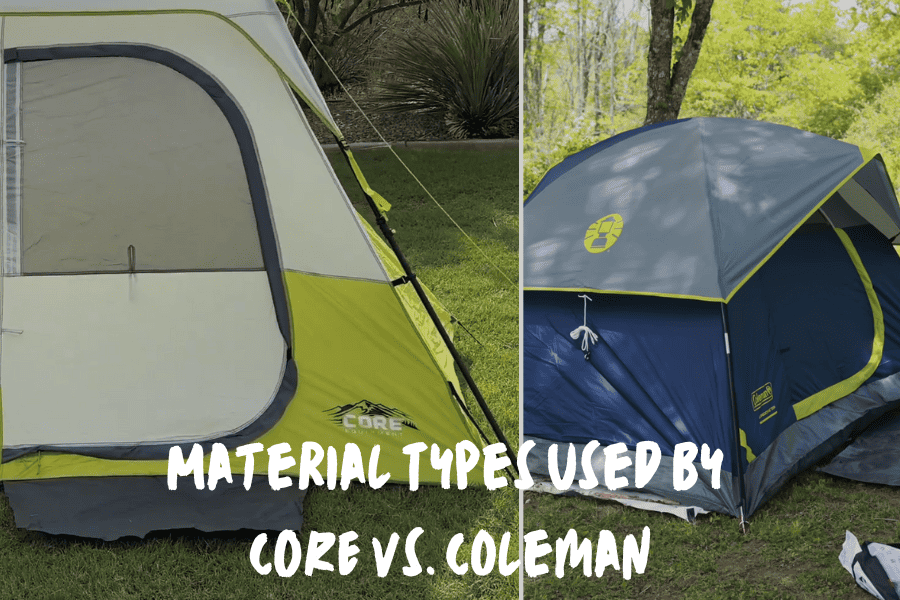
Tent Fabric:
Let’s start with CORE Equipment. Depending on the series, tents from this brand are usually made of either 75D or 68D polyester.
Both fabrics are somewhat of a standard option for tents, due to their good wear-and-tear resistance and low weight.
The only exception to the rule is the Performance series – tents from this series are made of 150D polyester, which is heavy-duty and suitable for longer exposure to both the sun and inclement weather.
Coleman uses the same materials as CORE, which are 68D and 75D polyester.
While the former is generally used for the tent body, the latter is used for the rain fly.
But for some single-walled tents, like the Coleman Instant Tent 4, a thicker fabric is used, which is 150D polyester, though those are the exceptions, not the rule.
Regardless, double-check the tent materials on any tent you buy and compare it directly to other options you are considering.
Verdict: It’s a tie!
Flooring:
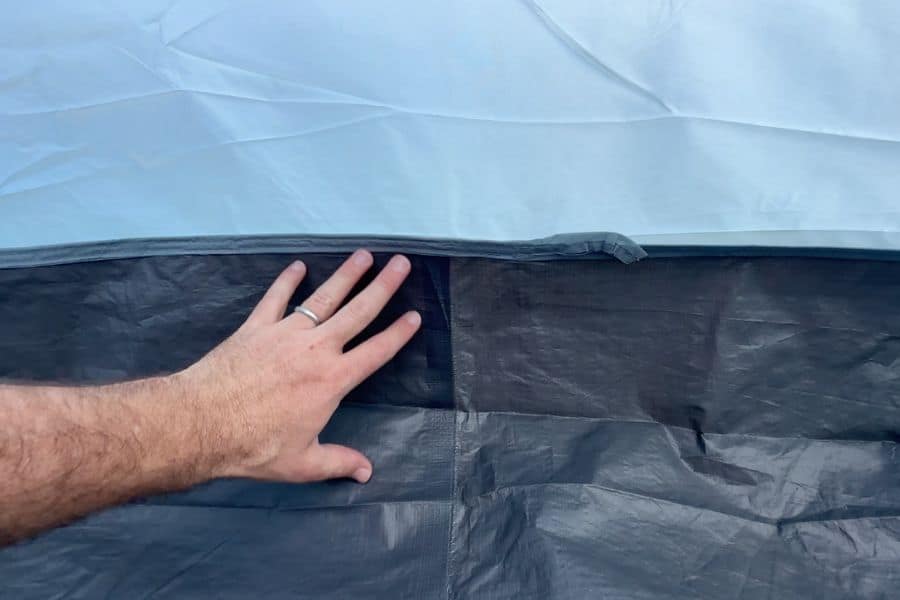
When it comes to tent floors, CORE generally uses 115gsm P.E. which is a durable, waterproof tarp-like material.
Coleman doesn’t generally disclose, but we find it comparable if not the same as the CORE material.
Some Coleman tents use 1000D polyethylene, which is a bit thicker, but that is the exception, not the rule.
Most of the difference lies in denier, which is a metric that refers to the thickness of individual fibers that make up the threads of a fabric.
Generally, a higher denier means thicker and more durable fabric.
But the biggest difference is that Coleman equips their tents with tub floors that rise up the wall of the tent 6 inches or so, while CORE does not.
So while the tent floors of both brands are waterproof and durable, the tub floors offered by Coleman tents give them a slight edge.
Verdict: Coleman has slightly better flooring given tub floors.
Tent Poles:
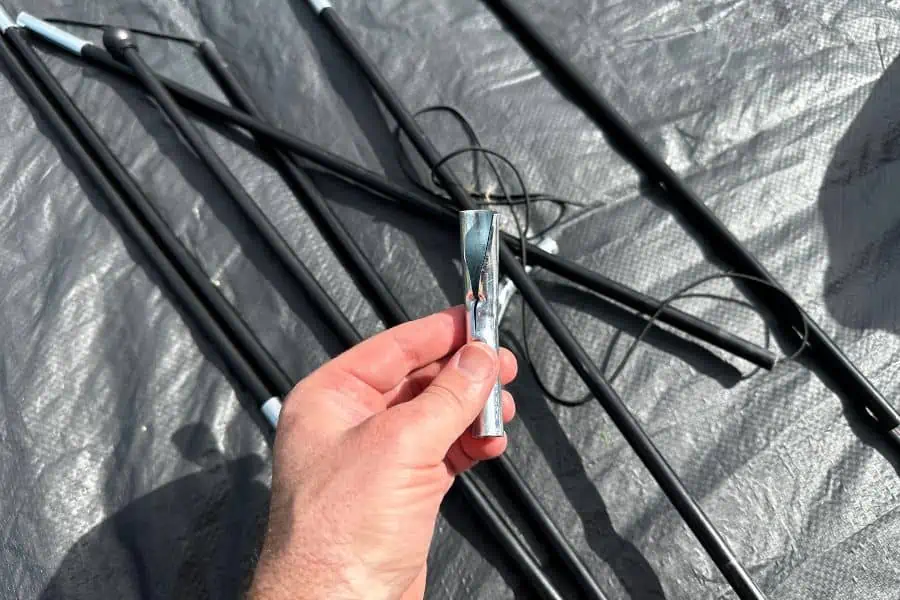
When it comes to tent poles, we can also see similarities between the two brands.
Both CORE and Coleman use fiberglass poles in many of their tents.
Instant tents feature poles that extend out via a push button.
Both brands use steel for instant tent poles and fiberglass for their hub parts.
CORE’s technology is significantly better when it comes to their instant tent poles, including spots for their rainfly to clip onto.
CORE’s fiberglass poles also don’t seem to break as easily. The aluminum they use to connect each portion together is of better quality.
Verdict: CORE has better overall fiberglass and instant tent poles.
Blackout Tent Material
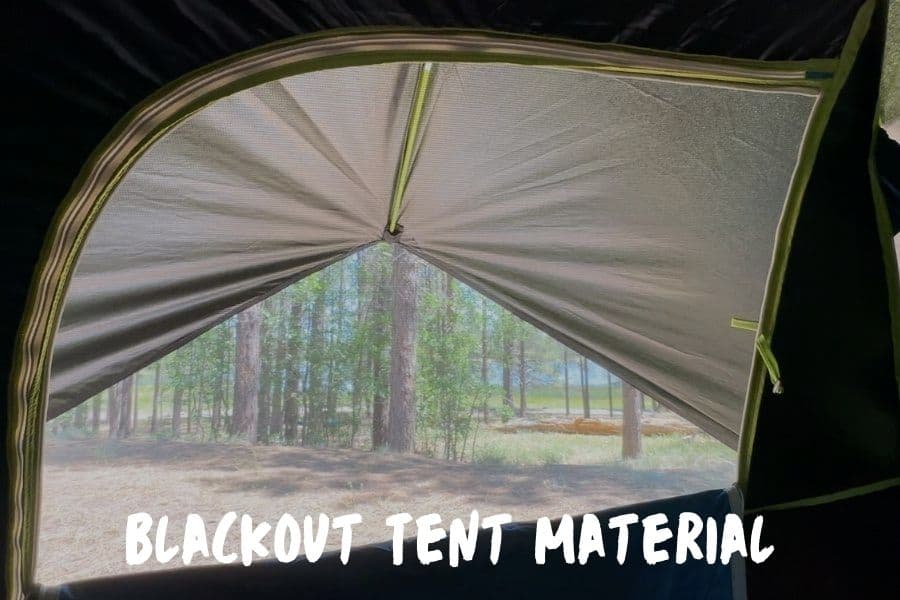
A blackout tent uses a specific technology to either minimize or completely block out light inside.
Some brands do that by simply using black fabric all over the interior. Coleman goes a step further.
Coleman’s BlackOut Bedroom® technology involves a PU coating on the underside of the rain fly.
Not only that, but the sleeping area is also made of a dark, breathable fabric.
Coleman has quite a few tents that use this technology, so if sleeping in late is what you’re looking for, there’s surely a model in the capacity you need.
So far, CORE has only come up with one blackout technology tent, which is no longer a part of the available series.
Verdict: Coleman is the only company currently offering this technology.
Weatherproofing/Flooring
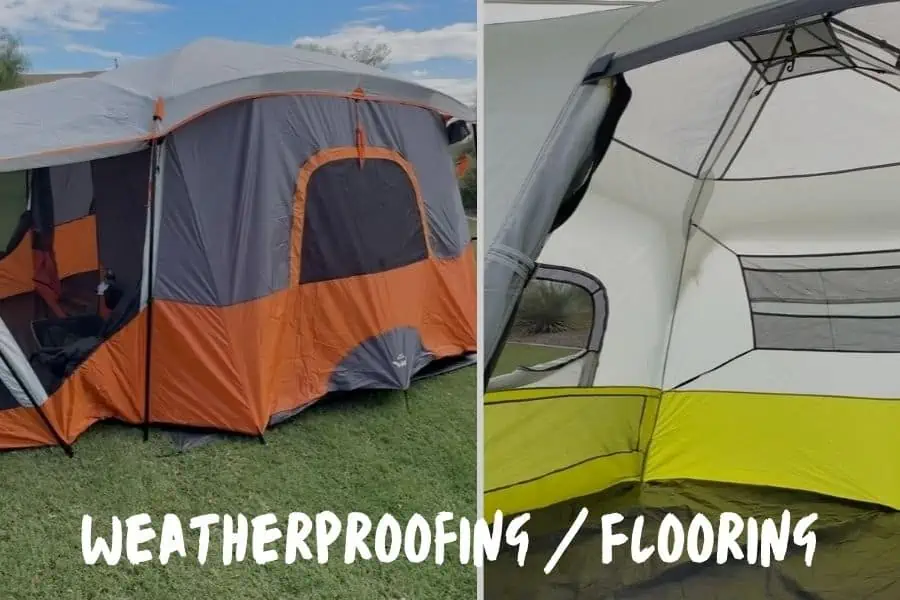
There are several factors to keep in mind when it comes to weather resistance. The tent material plays a role in it.
Polyester, the material both brands use, is generally considered to be water-resistant since it’s a polymer.
The fibers on their own are waterproof, but since they’re woven, the gaps in the fabric will let water pass through.
Therefore, it needs to be coated with a layer of polyurethane to make it resist water better. The more layers are applied, the more the fabric can resist moisture under pressure.
PU Ratings
The water resistance of the fabric is expressed through PU rating, and it ranges from 500mm to 10,000mm and more.
Tents with a PU rating between 500mm and 1000mm can withstand a light drizzle.
For heavy rainfall, you’ll need a tent with a PU rating of at least 1,500mm. Finally, tents with a rating of around 3,000mm are suitable for alpine conditions.
CORE tents all generally have the same PU rating, which is 1200mm. This means they’ll keep you dry in light rain.
As for Coleman, the brand is rather generous with PU coating. The lowest Coleman tents go is a PU rating of 2,000mm, which can withstand heavy rainfall.
As for the highest, tents from the Castle Pines series all have a PU rating of a whopping 6,000mm! We’ve already established that both brands use polyethylene for tent flooring.
In terms of water resistance, the thickness of the fabric doesn’t play a big role. But what does play is the design of the floor.
If there’s a puddle outside the tent, it can leak inside through the tent walls, as they’re not completely waterproof.
To avoid that from happening, Coleman uses the bathtub design. This essentially means that the waterproof fabric on the floor extends up the side tent walls for a few inches.
However, CORE tents don’t have a bathtub design, which makes them more prone to getting wet in the case of puddles.
Verdict: Coleman has slightly better overall PU ratings, plus tub floors.
Quality & Durability
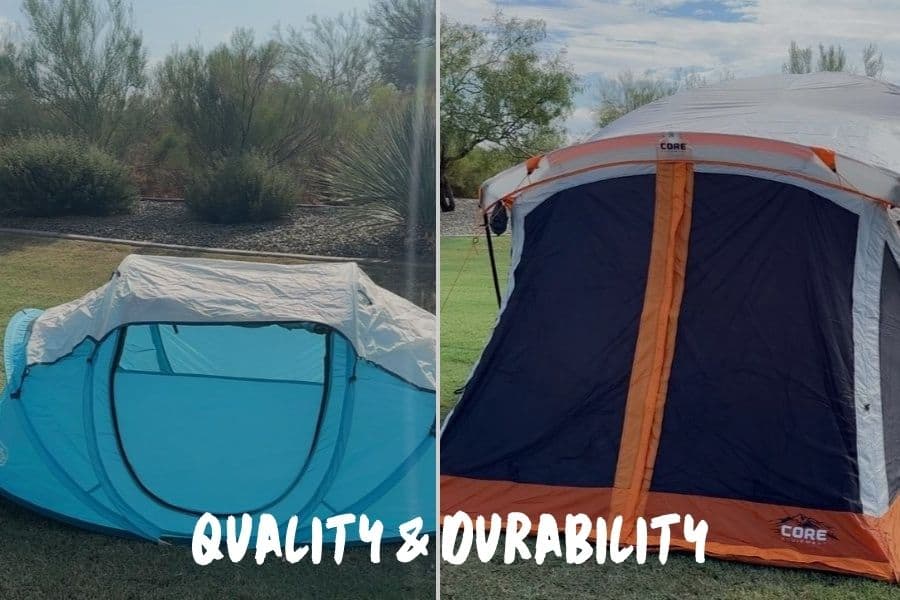
When talking about quality and durability, we can’t skip mentioning tent material.
However, both CORE and Coleman use the same fabrics, so they’re equal in that matter.
Another feature that determines the overall quality of a tent is zippers.
Both brands use non-branded zippers, and they are of similar quality.
It’s funny because on a spec per spec basis, you’d think that Coleman would slightly edge out CORE here, from our experience CORE tents hold up better.
They are simply constructed better and they have less defects.
We have yet to have a pole snap on us when testing a CORE tent.
Verdict: CORE edges out Coleman here.
Warranty: CORE Vs. Coleman
When it comes to warranty, tents from both brands are only covered for a year.
The warranty is limited, meaning it only guarantees the product is free from defects in material and workmanship.
In the case of both Coleman and CORE, the warranty doesn’t cover normal wear and tear, damage caused by misuse or improper care, and accidental damage.
Verdict: Tie!
Weather Resistance
We’ve already talked about how PU ratings and tent floor designs affect the weather resistance of tents.
However, that’s barely scratching the surface of the subject. In this section, we’ll analyze the weather resistance of tents from both brands and then compare them.
Weather Resistance In CORE Tents
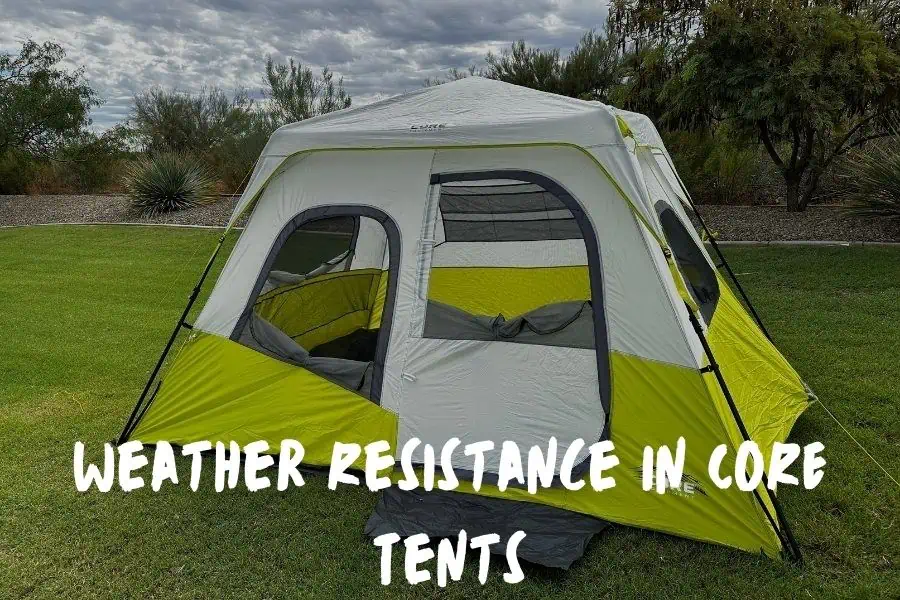
All CORE tents are equipped with the H2O Block Technology, which is a fancy name for a group of features that work together to fight the elements.
First, we have the water-resistance coating, which in the case of CORE tents, has a rating of 1,200mm. That’s pretty decent, as it can withstand light rain without a problem.
Now, even though the water drops slide down the fabric instead of penetrating through it, there are spots where it can get inside. Those spots are seam holes.
To prevent that from happening, CORE uses a technique of inverted stitching, which ensures that all edges are secured with more layers.
Not only that, but the seams are also taped-heat-sealed, so they prevent water from penetrating through.
Many CORE tents feature a detachable rain fly. However, only a handful of them have a rainfly that goes all the way to the ground.
In the case of both rain and wind, you can expect the rain to get through the windows unless you keep them completely zipped up.
As we already established, CORE tents don’t have bathtub floors. In the case water starts collecting on the ground around the tent, it can find its way inside.
But at least it won’t go through the zipper! CORE tents feature zipper covers, which prevent the water from getting through zipper teeth.
Weather Resistance In Coleman Tents
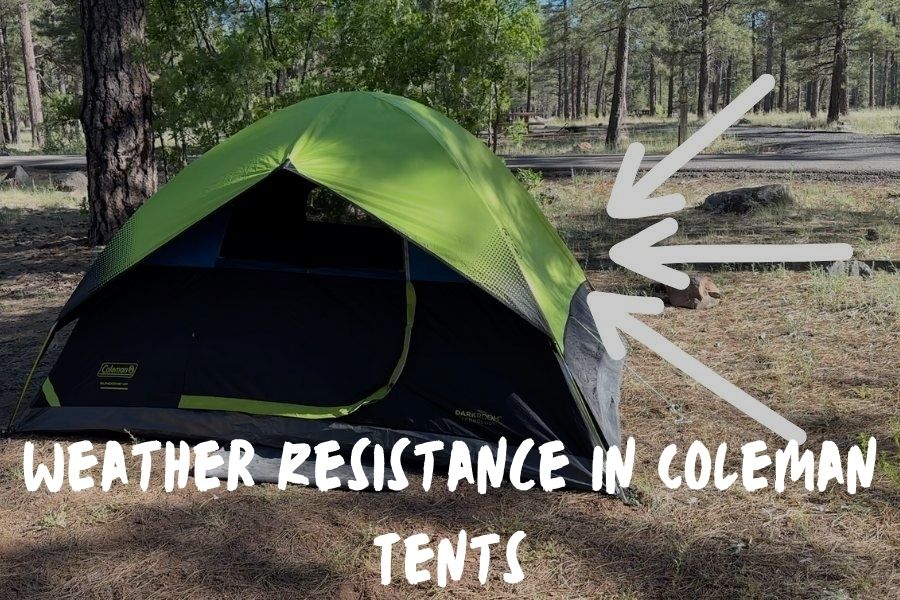
Coleman tents feature the so-called WeatherTec™ system. Again, this is a fancy name for several weatherproofing features.
Like CORE, Coleman also offers both single-walled and double-walled tents. In the case of dome tents, the rain fly typically reaches the ground, so it provides excellent resistance against the elements.
As for instant tents, some feature short rain flies that only cover the roof, while others are single-walled.
However, all Coleman tents have good water resistance, so they can withstand heavier rainfall than CORE tents.
Coleman tents also feature bathtub floors, which keep water from puddles out of the tent.
They also include inverted stitching and zipper cuffs, but the seams aren’t heat-sealed.
Verdict: Again, on paper, Coleman is putting out a better product, but in reality, CORE tents hold up better to the elements.
This will depend on a tent-by-tent basis, but CORE has a slight edge.
Ventilation

Good ventilation is just as important as weather resistance. You don’t want to feel like you’re in a sauna due to all the condensation and lack of air.
Both brands offer tents with mesh windows. Depending on the series, the tent walls may also be covered partially or completely in mesh.
But that’s not enough to ensure good airflow inside, especially when the rain fly is on.
Pretty much every CORE model features lower air intake vents. These openings allow chilled air to get inside and make for a breathable interior, while preventing rain from getting inside.
Just a handful of Coleman tents feature ground vents. Those that don’t, rely on either top vents or side windows to ensure ventilation.
That isn’t generally the issue unless it’s both rainy and windy, and the raindrops are blown inside the tent.
Verdict: CORE wins by a long shot!
Prices & Value
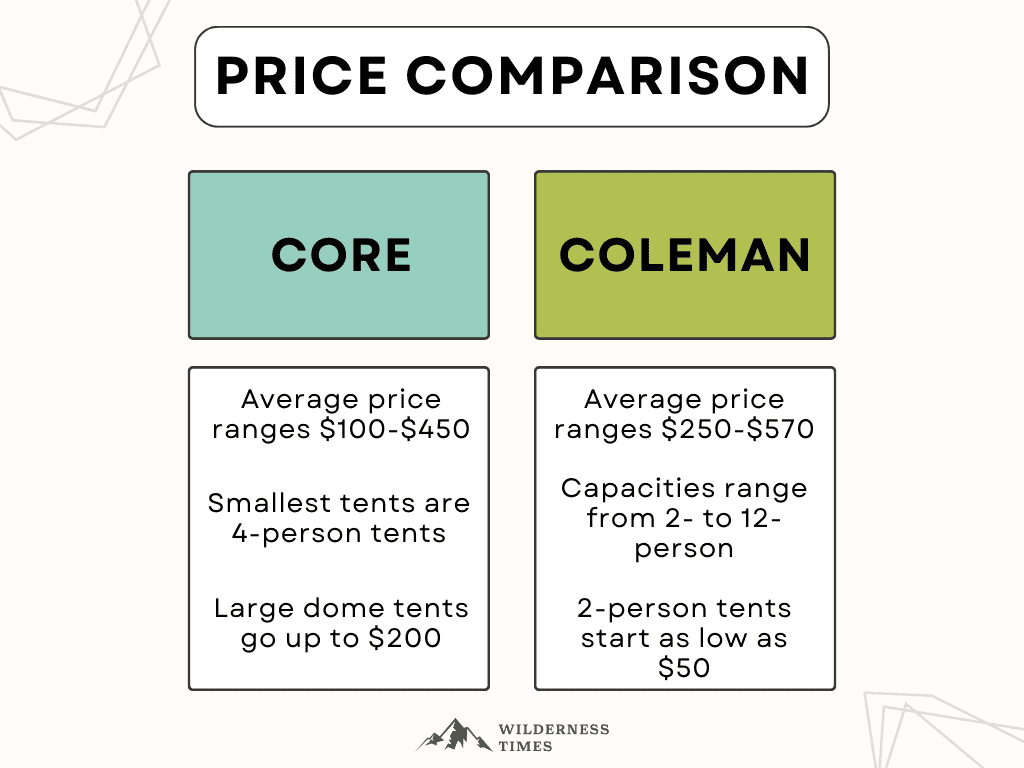
Let’s be real – the price of a tent is an important factor to consider when buying one.
In general, we can say that Coleman tents are slightly cheaper than CORE tents, but that’s not always the case.
Average Price Range For CORE Tents
CORE tents can range in price from $100 to $450, depending on the series.
Dome and cabin tents are generally similar, with their cost being determined by their capacity.
The brand’s smallest tents in both categories are 4-person tents, and they’re at the bottom end of the price spectrum.
As for the other end of the spectrum, the difference in cost is quite apparent between different styles.
While large dome tents go up to $200, cabin tents go higher. If they’re also instant, then they can cost $400 or more.
Average Price Range For Coleman Tents
While CORE specializes in family tents, Coleman tents really come in all capacities, from 2- to 12-person.
So naturally, there’s a larger discrepancy between the brand’s cheapest and most expensive models.
Tiny, 2-person tents start as low as $50, but can cost twice the amount depending on the features they have.
As for the huge, group tents, they can range from just $250 to $570.
Again, the price depends on the series and the unique features and materials it involves. Instant tents are generally more expensive than classic tents.
Value For Money Analysis
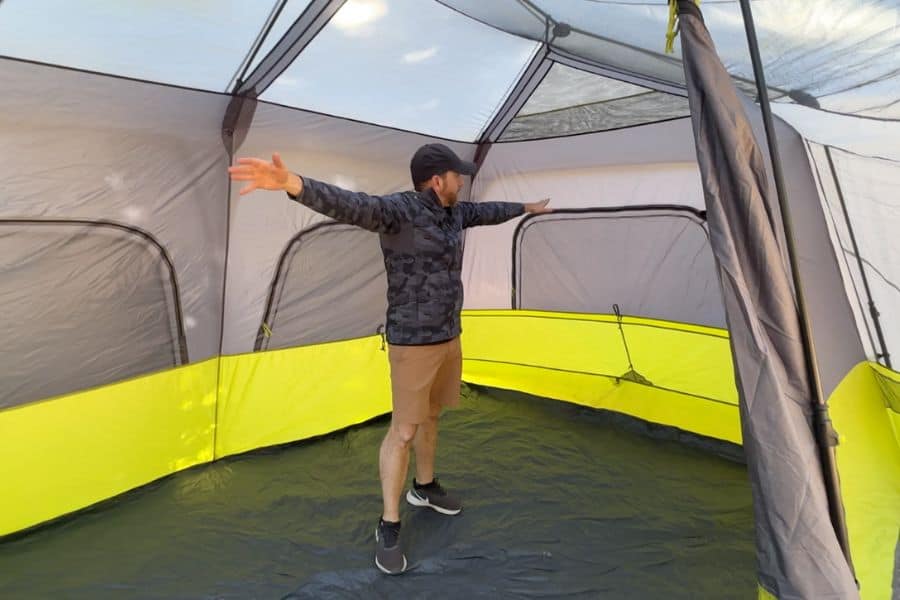
If we are to compare tents of the same style and capacity from both brands, in most cases, CORE will be slightly more expensive.
However, that difference is not for nothing. CORE tents focus on innovative features, which differ from model to model. Overhead gear loft, low intake air vents and built-in LED lighting are just a few.
This is not to say that Coleman tents might not have unique features on their own. But most Coleman tents are designed to be more budget-friendly and thus available to more campers.
Verdict: CORE slightly edges out Coleman on value.
Customer Reviews & Reputation
Finally, the best method of figuring out whether a tent is right for you is to go see what others think of it.
Luckily nowadays, you can find customer reviews online and easily get a glimpse of their experience.
CORE Tent Reviews
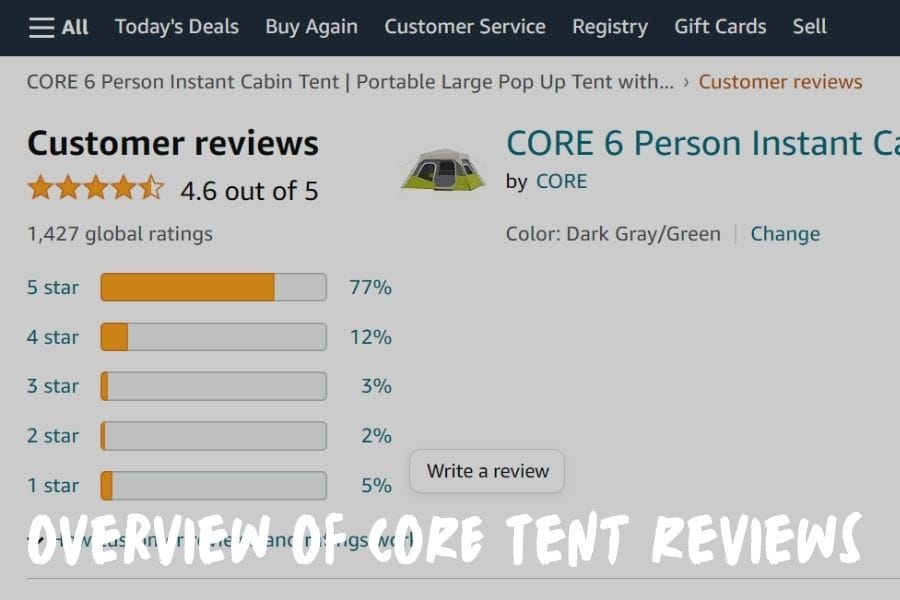
For the most part, users of CORE tents are satisfied with a few things:
- Ease of set up
- Decent materials
- Ample space
- Cool features
Regardless of the tent style, all CORE tents are designed with simplicity in mind. Instant tents are generally a breeze to pitch due to all poles being pre-connected.
But CORE tents are even easier, as they feature more than one hub, allowing a single person to set the whole thing up.
In the case of most non-instant tents, they have color-coded poles that match the part of the tent they should be attached to.
One thing many customers showed dissatisfaction with is the zipper quality. The zippers on CORE tents tend to snag on fabric, even causing damage.
Of course, you can avoid that by keeping the fabric around the zipper taut and slowly unzipping it, but sometimes that’s quite a hassle.
The other would be its waterproofness. While inverted stitching and taped seams are great, the fabric has a PU rating of just 1,200mm, so it’s not ideal for heavy downpours.
Plus, since there’s no bathtub floor design, water can get from the sides of the tent.
CORE has an average user rating of 4.55.
Coleman Tent Reviews
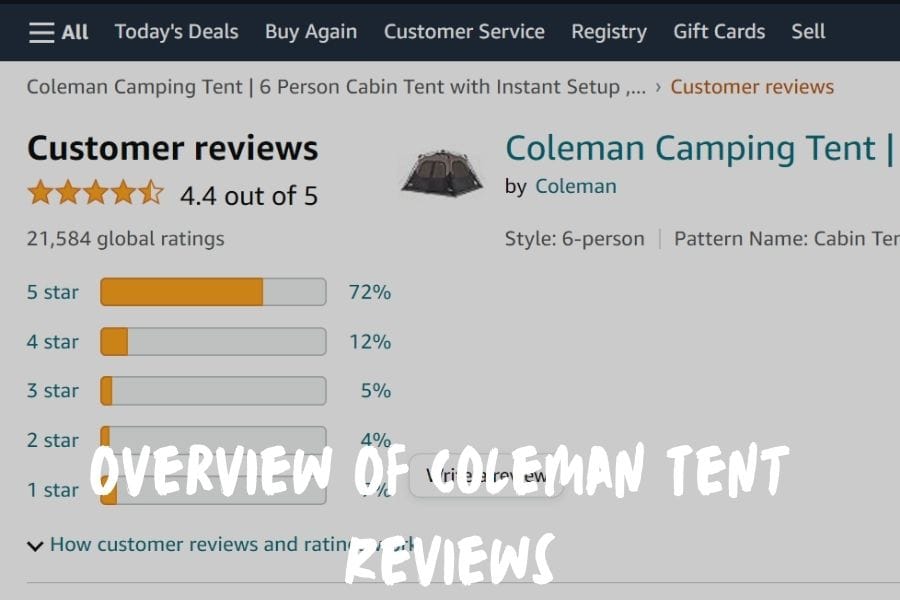
For most customers, the low price tag of Coleman tents was the main reason they went for the brand.
Coleman is also a classic camping brand and this nostalgia is something that helps some users to overlook obvious design flaws in some products.
In most cases, it’s the fact that these tents don’t have tons of bells and whistles.
For instance, storage options aren’t as creative as the ones found on CORE tents. In most cases, they feature a pocket or two for storing essentials.
Storage bags also aren’t as easy to use on Coleman tents which is another issue.
But the biggest complaint by far and aware are defects. Tent poles breaking, massive leaks from seams ripping, the types of horror stories that you wish to avoid when camping.
Of course, this happens to CORE too, but not as often.
Coleman has an average user rating of 4.3.
Verdict: CORE has better average user reviews coming in at 4.55 vs 4.3. There simply aren’t as many defects.
FAQs
What’s The Best CORE Tent?
The CORE 6-Person Instant Cabin Tent is widely considered to be the best tent from the brand.
It’s a breeze to set up, has an ample interior, and provides amazing ventilation. Plus, all that comes for quite a fair price.
What’s The Best Coleman Tent?
Arguably, the Coleman Sundome Tent is Coleman’s best and most loved tent. After years on the market, it continues to be a best seller.
It has great weather resistance, it’s a breeze to set up, and it comes in several capacities and variations (such as offering a blackout fabric).
Are CORE Tents Better Than Coleman Tents?
CORE tents aren’t necessarily better than Coleman in every category. Where they excel is in overall quality & durability, value, and ease of use.
The brand’s instant tents are considered among the easiest and sturdiest ones on the market.
Are Coleman Tents Better Than CORE Tents?
Coleman tents are arguably better than CORE tents in terms of weatherproofing.
Pretty much every Coleman tent is designed to withstand heavy downpours, which is not the case with CORE tents.
Can CORE & Coleman Tents Withstand High Winds?
That depends on the tent style.
Most cabin tents aren’t designed to withstand high winds, although both brands claim their models are tested and passed the “wind test” of up to 35 mph.
What’s The Lifespan Of CORE Vs. Coleman Tents?
Ultimately, it depends on how well you take care of it.
In ideal cases, you can expect both brands to last you four to five years depending on use.
READ: How Long Do Tents Last? What To Expect from Your Tent’s Lifespan
Are Replacement Parts Available For Both Brands?
Both brands offer at least some replacement parts. In the case of CORE, pole joints and connectors, as well as rain flies, can be bought separately.
Coleman has a somewhat smaller range of replacement parts, which mainly includes poles and rain flies for a few models.
Who Makes CORE Tents?
CORE Equipment is relatively new in the camping equipment market.
The company was founded by outdoor enthusiasts who left their corporate jobs to focus on making quality camping products.
It didn’t take long for the brand to become one of the most popular ones in the category, especially when it comes to tents.
CORE tents are well known for their reliability, durability, and overall performance.
Who Makes Coleman Tents?
Coleman is a brand that’s been around for over a century!
Founded in 1900 by Willian Coffin Coleman, the brand first focused on selling gasoline pressure lamps. The product range slowly expanded to camping stoves, coolers, and eventually tents.
Over the years, the brand went through a few acquisitions before becoming a subsidiary of Newell Brands.
Coleman tents are generally most known for their affordable price and are often a brand of choice for those just getting into camping.
To Sum Things Up
As you can see, there are many similarities between the two brands when it comes to tents. Both make fairly affordable tents and specialize in making them easy to use.
While both brands have their plusses and minuses, we find that on average CORE edges out Coleman where it matters:
CORE | Coleman | |
Best For | Value Brand | Budget Brand |
Price | $ | $ |
Sizes | 4 to 12 | 2 to 12 |
Warranty | 1 Year (Limited) | 1 Year (Limited) |
Average Tent Score | 8.0 | 7.4 |
Space & Comfort | ||
Quality & Durability | ||
Weather Resistance | ||
Tent Variety | ||
Value | ||
Ease of Use | ||
User Reviews |
Read More About CORE & Coleman:


